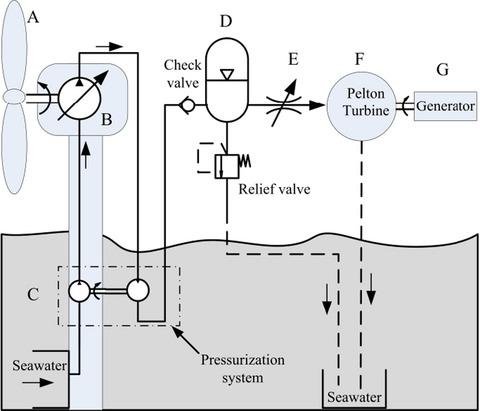当前位置:
X-MOL 学术
›
Energy Sci. Eng.
›
论文详情
Our official English website, www.x-mol.net, welcomes your
feedback! (Note: you will need to create a separate account there.)
Adaptive fuzzy Proportion Integration Differentiation control in hydraulic offshore wind turbine for optimal power extraction based on the estimated wind speed
Energy Science & Engineering ( IF 3.5 ) Pub Date : 2020-01-15 , DOI: 10.1002/ese3.618 YaJun Fan 1 , AnLe Mu 2
Energy Science & Engineering ( IF 3.5 ) Pub Date : 2020-01-15 , DOI: 10.1002/ese3.618 YaJun Fan 1 , AnLe Mu 2
Affiliation

|
In this paper, a novel fuzzy Proportion Integration Differentiation (PID) controller is proposed to extract the optimal energy from wind for a hydraulic offshore wind turbine. Firstly, in order to calculate the theoretical power, an adaptive neuro‐fuzzy inference system (ANFIS) is designed for wind speed evaluation, in which the input parameters include rotor speed, rotor torque, and pitch angle, and the output parameter is the estimated wind speed. Then, the optimal power coefficient is achieved by controlling the hydraulic pump torque to tracking the optimal rotor speed, and a fuzzy PID is designed to adjust the pump displacement and to obtain the optimal hydraulic pump torque. Furthermore, aiming to meet the various output power demand, a hydraulic accumulator is utilized for storing the excess energy, and a PID controller is designed for distributing the hydraulic energy between the accumulator and the Pelton turbine. Finally, the performance of proposed controls system are confirmed by two case simulations on a 5 MW hydraulic offshore wind turbine. The simulation results show that, compared with the conventional control methods (fuzzy logical and PID controller) used in electro‐hydraulic servo system, the fuzzy PID controller can provide the better tracking effect with a faster speed and a minimal steady‐state oscillation. Moreover, with the use of a hydraulic accumulator, all the power fluctuations from the wind speed disturbances are damped out and the output power become controllable.
中文翻译:

基于估算风速的水力海上风力发电机自适应模糊比例积分微分控制
本文提出了一种新颖的模糊比例积分微分(PID)控制器,以从水力海上风力涡轮机的风中提取最佳能量。首先,为了计算理论功率,设计了一种用于风速评估的自适应神经模糊推理系统(ANFIS),其中输入参数包括转子速度,转子转矩和桨距角,输出参数是估计值。风速。然后,通过控制液压泵扭矩以跟踪最佳转子速度来获得最佳功率系数,并设计了模糊PID以调节泵排量并获得最佳液压泵扭矩。此外,为了满足各种输出功率需求,液压蓄能器用于存储多余的能量,PID控制器设计用于在蓄能器和Pelton涡轮之间分配液压能。最后,通过对5 MW海上液压风力涡轮机进行的两个案例模拟,证实了所提出的控制系统的性能。仿真结果表明,与电液伺服系统中使用的常规控制方法(模糊逻辑和PID控制器)相比,模糊PID控制器可以以更快的速度和最小的稳态振荡提供更好的跟踪效果。而且,通过使用液压蓄能器,风速扰动引起的所有功率波动都被抑制,输出功率变得可控。拟议的控制系统的性能通过5 MW海上液压风力发电机的两个案例模拟得到了证实。仿真结果表明,与电液伺服系统中使用的常规控制方法(模糊逻辑和PID控制器)相比,模糊PID控制器可以以更快的速度和最小的稳态振荡提供更好的跟踪效果。而且,通过使用液压蓄能器,风速扰动引起的所有功率波动都被抑制,输出功率变得可控。拟议的控制系统的性能通过5 MW海上液压风力发电机的两个案例模拟得到了证实。仿真结果表明,与电液伺服系统中使用的常规控制方法(模糊逻辑和PID控制器)相比,模糊PID控制器可以以更快的速度和最小的稳态振荡提供更好的跟踪效果。而且,通过使用液压蓄能器,风速扰动引起的所有功率波动都被抑制,输出功率变得可控。模糊PID控制器可以以更快的速度和最小的稳态振荡提供更好的跟踪效果。而且,通过使用液压蓄能器,风速扰动引起的所有功率波动都被抑制,输出功率变得可控。模糊PID控制器可以以更快的速度和最小的稳态振荡提供更好的跟踪效果。而且,通过使用液压蓄能器,风速扰动引起的所有功率波动都被抑制,输出功率变得可控。
更新日期:2020-01-15
中文翻译:

基于估算风速的水力海上风力发电机自适应模糊比例积分微分控制
本文提出了一种新颖的模糊比例积分微分(PID)控制器,以从水力海上风力涡轮机的风中提取最佳能量。首先,为了计算理论功率,设计了一种用于风速评估的自适应神经模糊推理系统(ANFIS),其中输入参数包括转子速度,转子转矩和桨距角,输出参数是估计值。风速。然后,通过控制液压泵扭矩以跟踪最佳转子速度来获得最佳功率系数,并设计了模糊PID以调节泵排量并获得最佳液压泵扭矩。此外,为了满足各种输出功率需求,液压蓄能器用于存储多余的能量,PID控制器设计用于在蓄能器和Pelton涡轮之间分配液压能。最后,通过对5 MW海上液压风力涡轮机进行的两个案例模拟,证实了所提出的控制系统的性能。仿真结果表明,与电液伺服系统中使用的常规控制方法(模糊逻辑和PID控制器)相比,模糊PID控制器可以以更快的速度和最小的稳态振荡提供更好的跟踪效果。而且,通过使用液压蓄能器,风速扰动引起的所有功率波动都被抑制,输出功率变得可控。拟议的控制系统的性能通过5 MW海上液压风力发电机的两个案例模拟得到了证实。仿真结果表明,与电液伺服系统中使用的常规控制方法(模糊逻辑和PID控制器)相比,模糊PID控制器可以以更快的速度和最小的稳态振荡提供更好的跟踪效果。而且,通过使用液压蓄能器,风速扰动引起的所有功率波动都被抑制,输出功率变得可控。拟议的控制系统的性能通过5 MW海上液压风力发电机的两个案例模拟得到了证实。仿真结果表明,与电液伺服系统中使用的常规控制方法(模糊逻辑和PID控制器)相比,模糊PID控制器可以以更快的速度和最小的稳态振荡提供更好的跟踪效果。而且,通过使用液压蓄能器,风速扰动引起的所有功率波动都被抑制,输出功率变得可控。模糊PID控制器可以以更快的速度和最小的稳态振荡提供更好的跟踪效果。而且,通过使用液压蓄能器,风速扰动引起的所有功率波动都被抑制,输出功率变得可控。模糊PID控制器可以以更快的速度和最小的稳态振荡提供更好的跟踪效果。而且,通过使用液压蓄能器,风速扰动引起的所有功率波动都被抑制,输出功率变得可控。











































 京公网安备 11010802027423号
京公网安备 11010802027423号